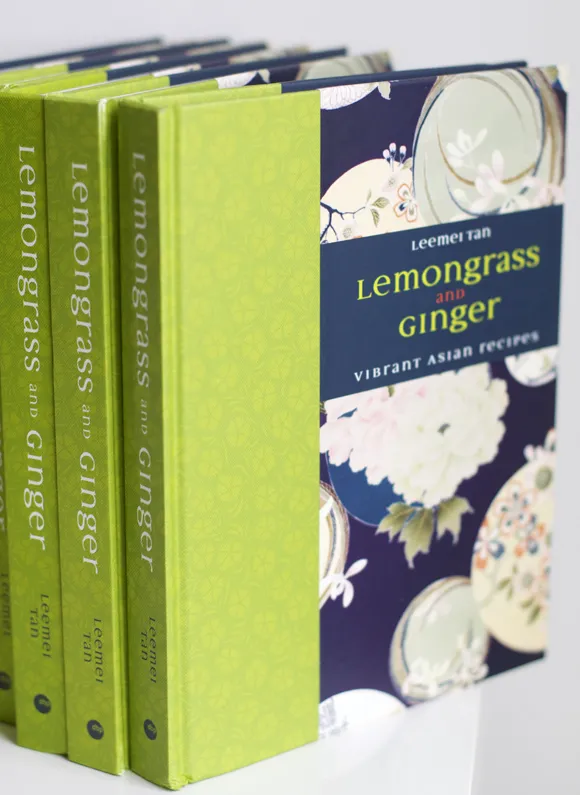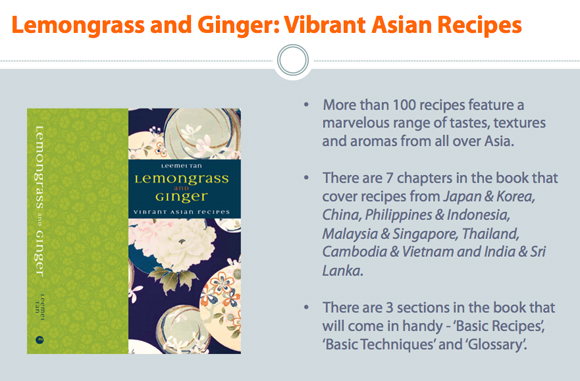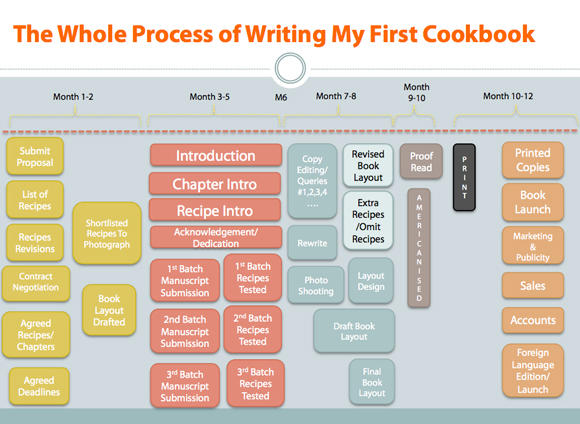Media
Getting Published: Pleasures and Pains of Writing Your First Cookbook

Just last Sunday, I was invited to talk at Food Blogger Connect 2012 in London. I have to say that it was such a great experience and I was glad to meet a lot of wonderful people! I had to dash off pretty early, how I wish I had stayed longer! Oh well, hopefully I will get to attend next year.
My session was at 09:30, to share a very interesting topic: Getting Published – Pleasures and Pains of Writing Your First Cookbook. I have received some great feedback on my presentation which I am very pleased. To be honest, I was pretty nervous. For a few times, my brain just went blank! I really want to thank those who were there for their supports! And I hope you have found my presentation helpful.
A few of you guys did miss it. But, I have good news for you all – those that did attend (to refresh your memory with my notes) and those that didn’t! If you want to know more of my very personal experience (which I didn’t get to elaborate during my presentation as I ran out of time!! You can read this post).
Hope you all will find this piece of information helpful. 😉 I truly welcome your feedback.
GETTING PUBLISHED – PLEASURES AND PAINS OF WRITING YOUR FIRST COOKBOOK
A. Introduction:
A few things that you would want to consider:
1. Agent or Publisher
- To approach an agent or a publisher may be your first question before you even start drafting your proposal.
- Consider the pros and cons of both. For example: the advantage: an agent will have vast knowledge and experience in publishing industry. Thus, will help you to find the best publisher and deal. On the other hand, you need to be aware that an agent will charge a certain percentage if he/she lands you a deal on your published title.
- Get a copy of Writers & Artists Year Book – this is a good starting point to have a list of all the agents and publishers with their contacts.
2. Choose the right agent or publisher
- Established publishers or agents that have great reputation and experience.
- Have published or handled similar titles as what you want to propose.
3. Preparation – this is covered in section B
4. Method of submission
- This is always specified by the publisher or agent. If not, find out the right person to speak to get information i.e. send an email to the right person at the publisher/agent to find out.
- Either by post of electronically.
B. Important Elements of A Cookbook Proposal:
1. Cover Letter
- Be concise. Give a summary of what your book is about.
- Give reasons why it would fill the gap in the market or how it would get people interested.
- Why you are the ideal person to write it.
- The cover letter should be no more than 1 page.
2. Synopsis
- Should be 1 to 2 pages.
- Describe the concept of the book, what needs it fulfils.
- It’s always a good idea to read the jacket flap copy of a book that give great synopsis.
- Do market and competitive research i.e. to prove that audience exists for such book idea.
- Specify your target market/audience i.e. beginners, home cooks etc.
- You can also take quote from publications to support your point on certain trends that your book is responding to.
3. Table of Contents/Lists of Recipes
- Give a sample outline of chapters/sections.
- Give a few sample recipes for each chapter/section.
4. Sample Recipes
- About 10-12 sample recipes to represent the concept of the book.
- Make sure the recipes are well-written, clear and concise.
- Consider to provide food photos to illustrate the sample dishes.
5. Biography
- “About the author” is to sell yourself. Who are you? Your qualification?
- Give a general introduction about yourself.
- Your personal food history i.e. learnt cooking when you were young; how you got into cooking (family influence.. etc)
- Mention about your food blog/website if you have one.
- Features in magazines/newspaper/web.
- Stands for “Self Addressed Stamped Envelope”.
- If you want your proposal to be sent back, always include one with sufficient postage. Otherwise, most publishers/agents won’t return it.
Extra notes: Get your proposal proof read by your friends/family members. Be prepared for rejections, it’s part and parcel of this whole process. Take it as a lesson learnt. All successful authors have been through this. So, don’t give up! And most importantly, be patient!
C. Formatting
A few aspects in formatting that you may want to consider:
- Good quality of A4 paper
- Double-space, boldface subheadings
- Easy to read type faces such as Times or Arial
- Use paper clips, do not staple
- Fresh page for each section
- Free of typos and incorrect grammar
- Electronic version (Word, PDF, or using desktop publishing software i.e. InDesign, Microsoft Publishing, etc).
D. My first cookbook
As a result of my determination, patience and not giving up! 🙂

E: The Whole Process of Writing My First Cookbook
Based on my experience, I can summarise the processes/steps that I have been through as per the diagram below. This should only be taken as an example as different publishers may work differently i.e. timing and some processes.
However, I think it will give you a general idea what are involved and how long it takes approximately to get a book published. (Please click on the image below to get a full-size digram.)



Wow.. Pat on your back.
Congratulations 😀
Such laborious process… Dont think I could handle the Stress 🙁
Thank you Lisa. It was a great learning experience for me. 😀
goz (plusixfive) and I are going to have a cookbook out soon (: How i wish we saw this earlier, could have saved us a whole lot of faff! congrats leemei on getting published btw, job well done xx
Thanks, Shu Han! Looking forward to know about yours & goz’s cookbook!!
It is defiantly worth all your sleepless nights and effort that you put in your book. Book looks beautiful with amazing recipes and images! Congrats again!!!
Thank you Sandra. Yes, I definitely it is well worth the effort. 🙂
Well done Leemei !!
I dont think i’d ever have the patience & perseverance – but somehow, I wish i could dedicate myself to such a process to document my mother’s wonderful skill at feeding us so well, for so little…
Did you find you had to adapt a lot of the recipes for the Westernised/ British palate as well?
Thank you! Well, I try to maintain most of its authenticity with a bit of modern twists. Some more accessible substitutions are suggested.
Great tips! I am ever so happy for you…
Cheers,
Rosa
Thanks Rosa. 😉
Hi Leemi,
It was lovely to meet you (albeit briefly) during the #FBC12 weekend. Thanks so much for taking the time to write up your account so succinctly. I was sorry to miss this presentation during the weekend so I really appreciate you capturing the salient points here. But most of all MANY CONGRATULATIONS xx
Hi Jacqueline,
Thanks for your wishes.
It was great to meet you briefly too! I hope this piece of information will help those who would want to get published. 🙂
Thank you so much for sharing the process of being published! And congrats for all the hard work and success my friend 🙂 xo
Thank you! I hope this piece of information will be helpful.
I didn’t know you were at FBC! We could have met…. I was there last year and decided to skip this year. Great recap of how to publish a cookbook… And it a lovely cookbook !!
Yeah I was there on Sunday! Shame that you were not there, and yes we could have met! Hopefully I will make it next year too!
I hope this piece of information will be useful and thanks for your kind words about my cookbook! 🙂
Thanks for sharing. I couldn’t make it to FBC so thanks.
No worries! 🙂
Wow… I have never thought of publishing a book before but after reading your post I appreciate books/cookbooks even more. Your cookbook has been my favorite and all of your hardwork really gave us such a great collection of your recipes. Thank you for your effort to make this book! Wishing you more success!
Thanks Nami for your kind words. 🙂
I was sad I didn’t get to hear your talk as I was at one of the workshops at FBC, but this post makes it all good!
Thank you for the valluable information, a book is every little bloggers dream I’m sure (mine too ssst don’t tell)
Many congratulations on your book, it was nice meeting you x
Oh that was a shame! I hope you have found this post useful. 😉 Thanks for your kinds words.
I have your cookbook and enjoy it thoroughly! I think you did a great job on that! Did you have to do your own layout and stuff? Or do you have editors and / or professionals to that? Thanks 🙂
I am glad that you love the book! Thank you.
Well, I didn’t have to do my own layout but I was involved in the process of setting the sequence the recipes in the book and also if a recipe will have photo or without.
Thank you Leemei for sharing the whole process here, you really kind. This is most precious for all of us. Terima kasih banyak!
Sama sama. 🙂
Thank you for sharing your experience in publishing your cookbook, Leemei. I saw your book at the store (MPH Bangsar Village — thought you might want to know) only to realize I’ve got http://www.mycookinghut.com bookmarked (twice!) in my laptop under different categories. We have much in common (Malaysian, living/lived abroad, French husband, love being in the kitchen, cooking, photography etc)… And yes, I’ve been dreaming about writing my own cookbook! Haha! Congratulations on having yours published and hope you’ll continue to do so — I’ll get your book tomorrow 🙂
Hi Sherine,
Thanks for dropping by and that brings me to your blog! we have so much in common!
Let me know what you think of my cookbook once you have it! 🙂
Thanks for sharing, I learned a lot from you I guess I need that for my 2nd cookbook. Btw, my first book was out in April too – Japanese Home Cooks.
I am the lucky one as I was approached by a publisher so I did not know about the proposal at all.
Congrats and hope to see more cookbooks from you.